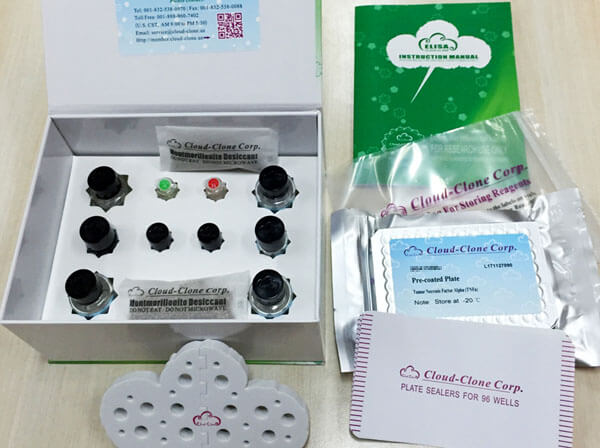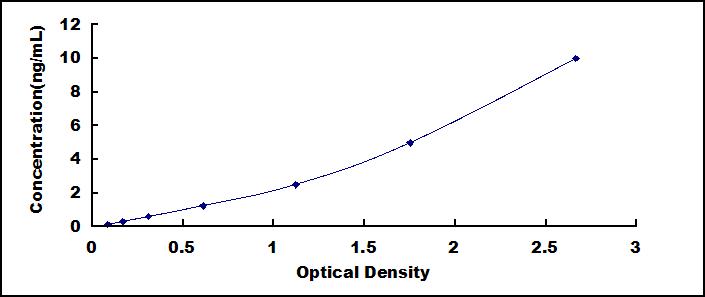ELISA Kit for Indoleamine-2,3-Dioxygenase (IDO) 

CD107B; INDO; Indoleamine-Pyrrole 2,3 Dioxygenase
- UOM
- FOB US$ 505.00 US$ 722.00 US$ 3,249.00 US$ 6,137.00 US$ 50,540.00
- Quantity
Overview
Properties
- Product No.SEB547Ra
- Organism SpeciesRattus norvegicus (Rat) Same name, Different species.
- ApplicationsEnzyme-linked immunosorbent assay for Antigen Detection.
Research use only - DownloadInstruction Manual
- CategoryEnzyme & KinaseInfection immunity
Sign into your account
Share a new citation as an author
Upload your experimental result
Review

Contact us
Please fill in the blank.
Recovery
Matrices listed below were spiked with certain level of recombinant Indoleamine-2,3-Dioxygenase (IDO) and the recovery rates were calculated by comparing the measured value to the expected amount of Indoleamine-2,3-Dioxygenase (IDO) in samples.
| Matrix | Recovery range (%) | Average(%) |
| serum(n=5) | 86-95 | 92 |
| EDTA plasma(n=5) | 97-104 | 101 |
| heparin plasma(n=5) | 96-105 | 101 |
Precision
Intra-assay Precision (Precision within an assay): 3 samples with low, middle and high level Indoleamine-2,3-Dioxygenase (IDO) were tested 20 times on one plate, respectively.
Inter-assay Precision (Precision between assays): 3 samples with low, middle and high level Indoleamine-2,3-Dioxygenase (IDO) were tested on 3 different plates, 8 replicates in each plate.
CV(%) = SD/meanX100
Intra-Assay: CV<10%
Inter-Assay: CV<12%
Linearity
The linearity of the kit was assayed by testing samples spiked with appropriate concentration of Indoleamine-2,3-Dioxygenase (IDO) and their serial dilutions. The results were demonstrated by the percentage of calculated concentration to the expected.
| Sample | 1:2 | 1:4 | 1:8 | 1:16 |
| serum(n=5) | 82-102% | 80-90% | 81-96% | 91-101% |
| EDTA plasma(n=5) | 92-99% | 94-103% | 81-103% | 83-99% |
| heparin plasma(n=5) | 84-92% | 82-95% | 97-105% | 95-102% |
Stability
The stability of kit is determined by the loss rate of activity. The loss rate of this kit is less than 5% within the expiration date under appropriate storage condition.
To minimize extra influence on the performance, operation procedures and lab conditions, especially room temperature, air humidity, incubator temperature should be strictly controlled. It is also strongly suggested that the whole assay is performed by the same operator from the beginning to the end.
Reagents and materials provided
| Reagents | Quantity | Reagents | Quantity |
| Pre-coated, ready to use 96-well strip plate | 1 | Plate sealer for 96 wells | 4 |
| Standard | 2 | Standard Diluent | 1×20mL |
| Detection Reagent A | 1×120µL | Assay Diluent A | 1×12mL |
| Detection Reagent B | 1×120µL | Assay Diluent B | 1×12mL |
| TMB Substrate | 1×9mL | Stop Solution | 1×6mL |
| Wash Buffer (30 × concentrate) | 1×20mL | Instruction manual | 1 |
Assay procedure summary
1. Prepare all reagents, samples and standards;
2. Add 100µL standard or sample to each well. Incubate 1 hours at 37°C;
3. Aspirate and add 100µL prepared Detection Reagent A. Incubate 1 hour at 37°C;
4. Aspirate and wash 3 times;
5. Add 100µL prepared Detection Reagent B. Incubate 30 minutes at 37°C;
6. Aspirate and wash 5 times;
7. Add 90µL Substrate Solution. Incubate 10-20 minutes at 37°C;
8. Add 50µL Stop Solution. Read at 450nm immediately.

Test principle
The test principle applied in this kit is Sandwich enzyme immunoassay. The microtiter plate provided in this kit has been pre-coated with an antibody specific to Indoleamine-2,3-Dioxygenase (IDO). Standards or samples are then added to the appropriate microtiter plate wells with a biotin-conjugated antibody specific to Indoleamine-2,3-Dioxygenase (IDO). Next, Avidin conjugated to Horseradish Peroxidase (HRP) is added to each microplate well and incubated. After TMB substrate solution is added, only those wells that contain Indoleamine-2,3-Dioxygenase (IDO), biotin-conjugated antibody and enzyme-conjugated Avidin will exhibit a change in color. The enzyme-substrate reaction is terminated by the addition of sulphuric acid solution and the color change is measured spectrophotometrically at a wavelength of 450nm ± 10nm. The concentration of Indoleamine-2,3-Dioxygenase (IDO) in the samples is then determined by comparing the O.D. of the samples to the standard curve.
Giveaways
Increment services
-
 Single-component Reagents of Assay Kit
Single-component Reagents of Assay Kit
-
 Lysis Buffer Specific for ELISA / CLIA
Lysis Buffer Specific for ELISA / CLIA
-
 Quality Control of Kit
Quality Control of Kit
-
 ELISA Kit Customized Service
ELISA Kit Customized Service
-
 Disease Model Customized Service
Disease Model Customized Service
-
 Serums Customized Service
Serums Customized Service
-
 TGFB1 Activation Reagent
TGFB1 Activation Reagent
-
 Real Time PCR Experimental Service
Real Time PCR Experimental Service
-
 Streptavidin
Streptavidin
-
 Fast blue Protein Stain solution
Fast blue Protein Stain solution
-
 Single-component Reagents of FLIA Kit
Single-component Reagents of FLIA Kit
-
 Streptavidin-Agarose Beads
Streptavidin-Agarose Beads
Citations
- CCL18 differentiates dendritic cells in tolerogenic cells able to prime regulatory T cells in healthy subjectsPubmed: 21803856
- Potential immunosuppressive function of plasma indoleamine 2,3-dioxygenase in patients with aGVHD after allo-HSCTWiley: source
- Secretion of Indoleamine 2, 3-Dioxygenase, an Immunomodulatory Substance, by Adipose-Derived Mesenchymal Stem CellIregway: Source
- CD40 Gene Silencing Reduces the Progression of Experimental Lupus Nephritis Modulating Local Milieu and Systemic MechanismsPubMed: PMC3683035
- Human CD14+ CTLA-4+ regulatory dendritic cells suppress T-cell response by cytotoxic T-lymphocyte antigen-4-dependent IL-10 and indoleamine-2,3-dioxygenase production in hepatocellular carcinomaPubmed: 23960017
- Indoleamine-2,3-dioxygenase elevated in tumor-initiating cells is suppressed by mitocansScienceDirect: S0891584913006345
- Cancer-Associated Fibroblasts from lung tumors maintain their immuno-suppressive abilities after high-dose irradiationFrontiersin:Source
- Immunogenicity and escape mechanisms of allogeneic tendon-derived stem cellsPubmed:24813640
- The expression of dendritic cell subsets in severe chronic rhinosinusitis with nasal polyps is alteredPubmed:24947894
- Chronic hepatitis C virus infection triggers spontaneous differential expression of biosignatures associated with T cell exhaustion and apoptosis signaling in peripheral blood mononucleocytesPubmed:25577277
- Cancer-Associated Fibroblasts from Lung Tumors Maintain Their Immunosuppressive Abilities after High-Dose IrradiationPubMed: 26029659
- Insights into the use of adipose stem cells for clinical cell therapy: Novel culturing conditions and characterization of multipotency and immunogenic propertiesHandle: 10024
- Respiratory Syncytial Virus-Infected Mesenchymal Stem Cells Regulate Immunity via Interferon Beta and Indoleamine-2, 3-Dioxygenasepubmed:27695127
- Exploring Amino Acid-Capped Nanoparticles for Selective Anti-Parasitic Action and Improved Host BiocompatibilityPubmed:29883557
- Mechanisms of Leptin and Ghrelin Action on Maturation and Functions of Dendritic Cells
- Cognitive Decline, Cerebral-Spleen Tryptophan Metabolism, Oxidative Stress, Cytokine Production, and Regulation of the Txnip Gene in 3xTg-AD MicePubmed: 30980800
- Interaction of the immune-inflammatory and the kynurenine pathways in rats resistant to antidepressant treatment in model of depressionPubmed: 31176083
- Richard Schäfer,* Gabriele Spohn, Marco Bechtel, 2 Denisa Bojkova, 2 Patrick C. Baer, 3 Selim Kuçi, 4
- Altered Indoleamine 2, 3-Dioxygenase Production and Its Association to Inflammatory Cytokines in Peripheral Blood Mononuclear Cells Culture of Type 2 Diabetes?¡33343199
- Richard Sch?fer,* Gabriele Spohn, Marco Bechtel, 2 Denisa Bojkova, 2 Patrick C. Baer, 3 Selim Ku?i, 4
- Associations between expression of indoleamine 2, 3-dioxygenase enzyme and inflammatory cytokines in patients with first-episode drug-naive …34802039








